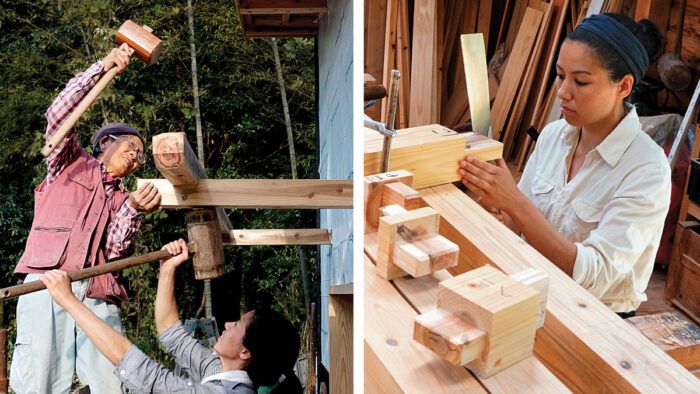Japanese joinery in practice
The Japanese craft of tekizami, hand preparation of timber by craftspeople, is not commonly seen in great detail by other than the masters who build with it.
Synopsis: The Japanese craft of tekizami, hand preparation of timber by craftspeople, is not commonly seen in great detail by other than the masters who build with it. But thanks to Emi Shinmura’s time spent working with her grandmother, Harumi, who is trained in this craft, we get an in-depth view of these masterful joints.
My aunt, Harumi Shinmura, is a traditionally trained residential carpenter working in Japan’s western island of Kyushu. She is a guiding figure in my life, and I’ve been fortunate to regularly learn a sliver of her craft while working on-site with her.
Part of my good fortune is because my aunt practices a disappearing craft. Tekizami, hand preparation of timber by craftspeople rather than entirely by machines, is unfortunately not common in Japan nowadays. Most houses are built with material precut in factories, including the joinery; the carpenter’s job is to assemble all the premade parts on-site. Sometimes, though, there are clients who value the quality of the long-established methods practiced by my aunt and others like her.
5 more spectacular Japanese joints
Learn how these joints go together
and why they were used

So was the case with my aunt’s recent project, a simple, single-story bunkhouse about 13 ft. by 26 ft. intended for cooking enthusiasts. The whole structure was made with cypress and cedar, which are ideal for Japan’s hot and humid climate. Timber buildings in general are particularly good at regulating moisture in these climates and have been developed over many centuries to survive adverse weather and earthquakes. Traditional buildings in Japan were built with longevity and repairability in mind. With careful maintenance, these buildings can last for centuries. Today, even traditional buildings in Japan, once all wood, are required to have metal fasteners and brackets (much to the despair of some traditional carpenters).
Knowing that my aunt’s carpentry knowledge was accumulated through many strict years of observing her master, I’m in a unique position to ask my aunt about her craft, something that is not allowed in a traditional apprenticeship. I feel honored to have a direct glimpse into this world, but it feels somewhat intrusive at the same time.
 To view the entire article, please click the View PDF button below.
To view the entire article, please click the View PDF button below.
From Fine Woodworking #292
To see more of Shinmura’s architectural illustrations, construction projects, and other art, go to her website, emishinmura.com; or her Instagram, @emi.shinmura.
 |
Joint Wizardry |
 |
Get Started with Japanese Joinery |
 |
Interlocking Chinese Joinery |
Fine Woodworking Recommended Products

Veritas Standard Wheel Marking Gauge

Suizan Japanese Pull Saw

Marking knife: Hock Double-Bevel Violin Knife, 3/4 in.





















Comments
Two people with, that's the way all my furniture joints go together.
Great article. Thank you.
Thank you for sharing your family's talents with us. The drawings and details were wonderful too.
This is so cool.
Log in or create an account to post a comment.
Sign up Log in